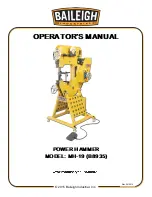
7 - English
OPERATION
INSTALLING/REMOVING BATTERY PACK
See Figure 2, page 10.
To install:
Place the battery pack on the tool.
Make sure the latches on each side of the battery pack
snap into place and the battery pack is secured on the
tool before beginning operation.
To remove:
Depress the latches on the sides of the battery pack.
Remove the battery pack.
For complete charging instructions, see the operator’s manu-
als for your battery pack and charger.
WARNING:
Battery products are always in operating condition.
Removing battery pack will prevent accidental starting
that could cause serious personal injury.
BLADE SELECTION
For best performance, always select a specific blade for
the particular application and type of material you wish to
cut. This will help create a smoother, faster cut and prolong
blade life.
WARNING:
This tool is designed to work with T-shank blades. Using
non-T-shank blades may result in blades coming loose
from tool, resulting in personal injury or property damage.
INSTALLING BLADES
See Figure 3, page 11.
The toolless blade clamp design does not require the use
of a blade wrench when installing or removing the blade.
Remove the battery pack.
Rotate the blade clamp lock counterclockwise. Hold the
lock in the open position.
Insert the T-shank saw blade into the slot and push until
the blade is fully inserted.
Release the blade clamp lock, making sure the blade is
securely installed.
Reinstall the battery pack.
BladeSaver
™
BRACKET
See Figure 4, page 11.
The BladeSaver
™
feature has a “drop-base” design. As the
blade becomes dull with use, the saw base can be adjusted
vertically in 1/8 in. increments, making unused blade teeth
available for cutting.
This feature can be used for straight cutting, bevel cutting,
and plunge cutting.
There are four detents on the side of the jigsaw for base
adjustment.
To adjust the BladeSaver
™
:
Remove the battery pack.
Remove the hex key from the storage compartment.
Loosen the two screws on the side of the bracket.
NOTE:
It is not necessary to remove the screws. Turn
them counterclockwise only enough to loosen the base
for adjustment.
Adjust the base to desired position indicated by the
detents on the BladeSaver
™
bracket.
Securely tighten the screws and reinstall the battery pack.
Return hex key to storage compartment.
The unused portion of the blade will vary, depending on
the thickness of the workpiece material and the length of
the blade.
GENERAL CUTTING
See Figure 5, page 11.
Rest the front of the saw base on the workpiece and align
cutting edge of the blade with the line on your workpiece.
Start the saw and move it forward on the work surface.
Apply downward pressure to keep the saw steady and only
enough forward pressure to keep the blade cutting. Do not
force the saw. Forcing the saw may overheat the motor and
break saw blades. Broken saw blades must be replaced with
new saw blades.
STRAIGHT CUTTING
See Figure 5, page 11.
A straight cut can be made by clamping a piece of wood or
straight edge to the workpiece and guiding the edge of the
saw against it. Make the cut from one direction only; don’t
cut halfway and complete the cut from the opposite end.
VARIABLE SPEED LEVER
See Figure 6, page 11.
The variable speed lever is located on top of the saw handle,
above the switch trigger.
To increase or decrease the cutting speed:
Hold the saw in normal operating position. Gradually push
the speed lever to the positive ( + ) symbol to increase
speed. Push to the negative ( − ) symbol to decrease
speed.
If you desire to lock the switch on at a given speed,
depress the switch trigger, push in and hold the lock-on
button, and release the switch trigger. Adjust the variable
speed lever until the desired speed is reached.
Avoid running the saw at low speeds for extended periods
of time. Running at low speeds under constant usage may
cause the saw to become overheated. If this occurs, cool
the saw by running it without a load and at full speed.








































